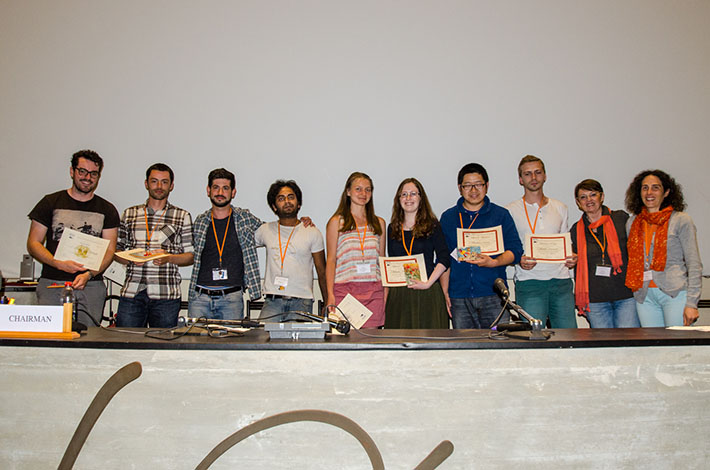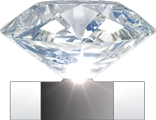A Report

Group photo
Note
To dowload the full size photo click on the image
The International School of Crystallography is based in Erice at the Ettore Majorana Foundation and Centre for Scientific Culture. So, as usual this 49th Course took place in this beautiful environment. As was the case for all the past editions, the event was advertise by mailing about 7000 announcements worldwide about one year ahead of the course. Over 120 applications were received and the large number as well as the exceptional quality of the applications made this process quite difficult, but at the end approximately 70 students were accepted for the Course (20 nations were represented). Participants were largely from university (Ph.D. students, postdoctoral and young researchers), with some members of companies working in the field.
The schedule for a typical day included a morning session, with four 45-minute lectures, followed by a lunch break. The afternoon session usually started with two lectures, followed by different types of workshops and tutorials.
The program was designed was to broadly focus on core experimental and theoretical high-pressure techniques in the first two days, introducing increasingly more specialized topics as the week progressed. Lectures were grouped according to logical research themes (basics of high-pressure research from experimental and theoretical perspectives, phase transitions, inelastic scattering and other complementary techniques to diffraction, techniques, molecular crystal, materials). The last two days were dedicated to state-of-the-art techniques and instrumentation, setting up the scene for the highly interactive combined round table/panel discussion session, where emerging challenges and opportunities in high-pressure research were discussed in greater detail. Fundamental topics covered in the course include experimental techniques for pressure generation (diamond anvil cells, large-volume presses), basics of X-ray and neutron diffraction on single crystal and powder materials, and comparative structural studies. These were demonstrated through examples of different chemical and structural complexity, from minerals to ices and biomolecules. Specialized and frontiers high-pressure research topics included computational crystallography, dynamic compression, characterization of liquids and glasses and pair distribution function analysis. The course was rounded up by illustrating the use of high-pressure as a means to study and access new materials for industrial application such as pharmaceuticals, energy storage, magnetic and ultra-hard materials.
The program contained 31 lectures given by 21 invited speakers and twelve fifteen-minute oral presentations by young participants (selected from the submitted abstracts). In addition, there were two software tutorials open to all participants and a total of ten workshops, each repeated at least twice over the course of the week. Most workshops took place in the afternoon and were bundled in up to four parallel sessions to allow student rotation. An electronic workshop sign up program was developed for the course and this has been, to best of our knowledge, the most workshops-intensive dedicated to crystallography in recent years.
Among the contributions of the young researchers, twelve were chosen to give an oral presentation during the Course. They were selected also on the basis of their research field. Following the list of the selected speakers:
- Davide Comboni (University of Milan, Italy);
- Piotr Gunka (University of Technology, Warszawa, Poland);
- Lauren Evelyn Connor (University of Strathclyde, Glasgow, UK);
- Andrew Cairns (ESRF, Grenoble, France);
- Hannah Shelton (University of Hawaii at Mānoa, HI, USA);
- Xenia Ritter (University of Münster, Germany);
- Christopher Woodall (University of Edinbrurgh, UK);
- Sulgiye Park (Stanford Univeristy, CA, USA);
- Dominique Laniel (CEA, Arpajon, France);
- Christian Childs (University of Nevada, NV, USA);
- Ramesh Devarapalli (IISER, Kolkata, India);
- Kirsten Schultze (University of Bayreuth, Germany).
The participants presented 52 posters in two evening poster sessions. The "poster preview during lunch" session, already implemented in the past editions, was implemented again this year and was very successful and appreciated by poster presenters and participants alike. Equally successful and particularly valuable for the young researchers were the 2 minute "come see my poster" précis immediately prior to each poster session. Several general events were organized during the day and in the evenings to further facilitate networking opportunities and scientific exchange among all participants.
Awards and participant Feedback

Prize winners
From left to right: Charlie McMonagle, Charles Pepin, Fabio Montisci, Rajikrishna Dutta, Anna Pakhomova, Eleanor Berryman, Dongzhou Zhang, Jerdjzei Marciniak, Paola Spadon and Annalisa Guerri.
Note
To dowload the full size photo click on the image
The afternoon of the last day (June 5th) were devoted to the appointment of the awards for the young researchers. The numerous posters were divided into categories and for each them a first, second and third place were selected by international juries. The awards for the third places were assigned to Fabio Montisci (University of Bern, Switzerland) and Rajkrishna Dutta (Princeton University, NJ, USA); Eleanor Berryman (TU Berlin, Germany) and Anna Pakhomova (University of Bayreuth, Germany) were awarded of the second place and finally the first places were conferred to Charles Pepin (EPFL, Switzerland) and Charlie McMonagle (University of Edinburgh, UK).
Another significant prize is the Lodovico prize,named after the founder of the School and recognizing the most active student inside and outside the lecture hall. Due to the relevant quality of the students, besides the prize itself, awarded to Jerdjzei Marciniak (Adam Mickiewicz University, Poland), there were two special mentions for the prize, for Eleanor Berryman (TU Berlin, Germany) and Dongzhou Zhang (Argonne National Lab, USA). Enclose a picture of the prize winners.
At the end of the Course, participants were asked to participate to a survey to judge and comment on the quality of the Course. Their responses indicates that a similar meeting should be held at least in 4 year time and that the course have been successful in most of its objectives (score 92/100).


 New experimental and theoretical approaches in the field of high pressure crystallography allow us to address fundamental scientific questions in disciplines such as Physics, Chemistry, Biology, Geosciences and Materials Science. High pressure - from the very modest pressure required to induce the denaturation of proteins and modify intermolecular interactions, through the higher pressures required to synthesise new materials for technological application, to the ultra-high pressures required to radically alter the chemical physical properties of simple elements and materials or recreate the conditions found in Earth's and other planets' interior - is making it a versatile and central tool in condensed matter science.
New experimental and theoretical approaches in the field of high pressure crystallography allow us to address fundamental scientific questions in disciplines such as Physics, Chemistry, Biology, Geosciences and Materials Science. High pressure - from the very modest pressure required to induce the denaturation of proteins and modify intermolecular interactions, through the higher pressures required to synthesise new materials for technological application, to the ultra-high pressures required to radically alter the chemical physical properties of simple elements and materials or recreate the conditions found in Earth's and other planets' interior - is making it a versatile and central tool in condensed matter science.

